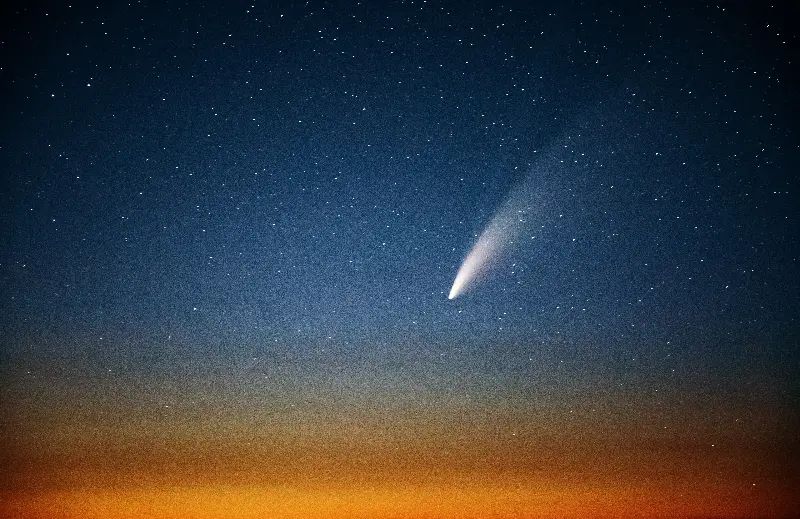Gazing up at the night sky, it's easy to be captivated by the sparkling trail of a distant visitor. Comets, with their glowing heads and luminous tails, have fascinated humanity for millennia. These icy wanderers offer us not only a breathtaking spectacle but also vital clues about the early solar system and perhaps even the origins of life itself. Let’s journey into the realm of comets, unraveling their mysteries and discovering some dazzling facts about these enigmatic travelers among the stars.

What Exactly Is A Comet?
Comets are often described as “dirty snowballs” floating in the depths of space, but there’s much more beneath their icy exteriors. Composed mainly of rock, dust, frozen gases, and organic compounds, comets orbit around the Sun in highly elliptical paths. Unlike asteroids, which are mostly rocky or metallic, comets contain significant amounts of volatile substances—materials that evaporate when heated by sunlight.
When they are far from the Sun, comets remain dark and cold, almost invisible. But as they approach the inner solar system, the Sun’s warmth heats their surfaces, causing the ices to vaporize and escape into space. This outgassing creates the stunning coma (a cloud of gas and dust) and the iconic tail that stretches for millions of kilometers.
Comets Through Human History
For ancient civilizations, comets were often seen as omens, heralding dramatic change—sometimes disastrous, sometimes auspicious. The sudden and unexpected appearance of a bright comet against the night sky was interpreted by many as a message from the gods. Halley’s Comet, perhaps the most famous of all, was chronicled for centuries and linked to historic events from the Battle of Hastings in 1066 to the death of Mark Twain.
It wasn't until the advent of modern astronomy that we began to truly understand comets, transitioning from myth to science. Today, comets serve as time capsules, holding materials virtually unchanged since the birth of the solar system over 4.6 billion years ago.
A Cosmic Origin Story
Most comets originate from two distant regions of our solar system: the Kuiper Belt and the Oort Cloud. The Kuiper Belt, located just beyond Neptune, contains thousands of icy objects—including dwarf planets like Pluto. Comets from here usually have shorter, quicker orbits (called short-period comets).
The Oort Cloud is even farther away, a spherical shell thought to encircle the entire solar system at a staggering distance of up to 100,000 astronomical units (AU) from the Sun. Comets arriving from the Oort Cloud, known as long-period comets, can have orbits lasting millions of years, making every appearance a truly rare event.

Tails Of Wonder: The Science Behind The Glow
One of the most spellbinding features of comets is their tail. In reality, comets can develop two distinct tails as they approach the Sun. The first is the dust tail, which is made up of tiny grains of dust pushed away from the coma by sunlight. This is what often gives a comet its glowing, golden appearance.
The second type, the ion tail, is formed when ultraviolet sunlight strips electrons from molecules in the coma, creating a stream of electrically charged particles. This tail glows with a bluish hue and always points directly away from the Sun due to the influence of the solar wind—a stream of charged particles emitted by our star.
Surprisingly, a comet’s tail always points away from the Sun, no matter what direction the comet is moving. This means that, after rounding the Sun, it can appear as if the tail is leading the comet.
Comets And The Origins Of Life
Could comets be responsible for life on Earth? While it might sound like science fiction, there’s growing evidence to support this tantalizing idea. Comets are packed with water ice and organic molecules—some of the same building blocks required for life.
Several space missions, including the European Space Agency's Rosetta mission, have detected complex molecules on comet surfaces, such as amino acids and sugars. Scientists theorize that during the early days of Earth, frequent impacts from comets may have delivered water and these organic compounds, seeding our planet with the ingredients necessary for life.
Up-Close And Personal: Humanity’s Missions To Comets
The last few decades have seen humanity’s curiosity about comets go beyond gazing from afar. In 1986, as Halley's Comet passed by Earth, spacecraft from several nations raced to intercept it. The European probe Giotto captured the first close-up images of a comet nucleus, revealing a jagged, blackened surface.
NASA’s Stardust mission successfully collected dust particles from Comet Wild 2 in 2004 and delivered them to Earth for analysis, providing an unprecedented glimpse into a comet’s composition. In a historic achievement, the Rosetta mission not only orbited Comet 67P/Churyumov-Gerasimenko but also deployed the Philae lander, marking the first-ever landing on a comet’s surface.

When Will You See The Next One?
Unlike planets or stars, comets are unpredictable guests. Some, like Halley’s Comet, follow regular paths, gracing our skies every 76 years. Others arrive with little warning, their bright tails visible for weeks or even months before vanishing once more into the void.
No matter when the next comet appears, one thing is certain: witnessing a comet streak across a dark sky is a magical experience, a reminder that our solar system is still alive with icy secrets and cosmic wonders waiting to be discovered. Comets, in their luminous journeys, continue to connect our modern world with the ancient mysteries of the universe—glittering travelers inviting us to keep exploring.
